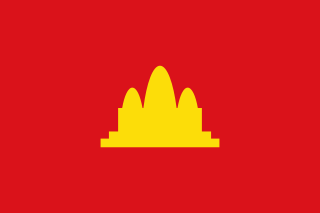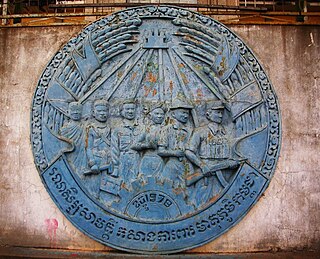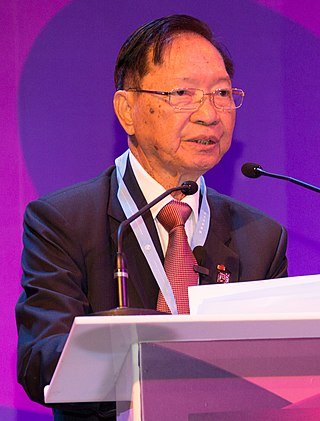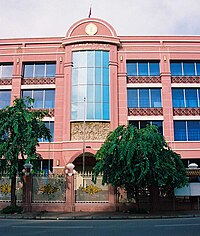
The Khmer Rouge is the name that was popularly given to members of the Communist Party of Kampuchea (CPK) and by extension to the Democratic Kampuchea through which the CPK ruled Cambodia between 1975 and 1979. The name was coined in the 1960s by Norodom Sihanouk to describe his country's heterogeneous, communist-led dissidents, with whom he allied after the 1970 Cambodian coup d'état.

Phnom Penh is the capital and most populous city of Cambodia. It has been the national capital since the French protectorate of Cambodia and has grown to become the nation's primate city and its economic, industrial, and cultural centre. Before Phnom Penh became capital city, Oudong was the capital of the country.
The riel is the currency of Cambodia. There have been two distinct riel, the first issued between 1953 and May 1975. Between 1975 and 1980, the country had no monetary system. A second currency, also named "riel", has been issued since 20 March 1980. Since the late 1990s, the riel has had an unofficial fixed exchange rate of 4,100:1 with United States dollar, Cambodia's second de facto currency for commercial transactions.

The Cambodian–Vietnamese War was an armed conflict between Democratic Kampuchea, controlled by Pol Pot's Khmer Rouge, and the Socialist Republic of Vietnam. The war began with repeated attacks by the Kampuchea Revolutionary Army on the southwestern border of Vietnam, particularly the Ba Chúc massacre which resulted in the deaths of over 3,000 Vietnamese civilians. On 23 December 1978, 10 out of 19 of the Khmer Rouge's military divisions opened fire along the border with Vietnam with the goal of invading the Vietnamese provinces of Đồng Tháp, An Giang and Kiên Giang. On 25 December 1978, Vietnam launched a full-scale invasion of Kampuchea, occupying the country in two weeks and removing the government of the Communist Party of Kampuchea from power. In doing so, Vietnam put an ultimate stop to the Cambodian genocide, which had most likely killed between 1.2 million and 2.8 million people — or between 13 and 30 percent of the country’s population. On 7 January 1979, the Vietnamese captured Phnom Penh, which forced Pol Pot and the Khmer Rouge to retreat back into the jungle near the border with Thailand.

Democratic Kampuchea was the official name of the Cambodian state from 1976 to 1979, under the totalitarian dictatorship of Pol Pot and the Communist Party of Kampuchea (CPK), commonly known as the Khmer Rouge. The Khmer Rouge's capture of the capital Phnom Penh in 1975 effectively ended the United States-backed Khmer Republic of Lon Nol.
ACLEDA Bank Plc. is a public limited company, formed under the Banking and Financial Institutions Law of the Kingdom of Cambodia. Based in Phnom Penh, with 261 offices covering all provinces, as well as 42 in Laos, and seven in Myanmar. ACLEDA started out in 1993 when it began providing micro credits to war victims. By now it is Cambodia's major commercial bank. ACLEDA had more than $5,244 million in total assets as of December 31, 2017, and more than $3,117 million in deposits, with over $3,085 million in loans outstanding. According to the National Bank of Cambodia, ACLEDA Bank is the largest domestic commercial bank in terms of total assets and number of clients, with more than 1.7 million depositors as of December 31, 2017.
Pen Sovan was a Cambodian politician and revolutionary who served as the Prime Minister of the Hanoi-backed People's Republic of Cambodia from 27 June 1979 to 5 December 1981. He also served as General Secretary of the Cambodia People's Revolutionary Party (CPRP) from 1979 to 1981. He was arrested and removed from office in December 1981 by the Vietnamese for irritating Lê Đức Thọ, the chief adviser to the PRK government. He was imprisoned in Vietnam until January 1992.

The People's Republic of Kampuchea (PRK) was a partially recognised state in Southeast Asia which existed from 1979 to 1989. It was a satellite state of Vietnam, founded in Cambodia by the Vietnamese-backed Kampuchean United Front for National Salvation, a group of Cambodian communists who were dissatisfied with the Khmer Rouge due to its oppressive rule and defected from it after the overthrow of Democratic Kampuchea, Pol Pot's government. Brought about by an invasion from Vietnam, which routed the Khmer Rouge armies, it had Vietnam and the Soviet Union as its main allies.

Norodom Boulevard, also called Street 41, is a major boulevard in Cambodia and one of Phnom Penh's oldest arterial roads. It was named after King Norodom. It connects with Monivong Bridge in the south-east of the city at the Bassac River and joins with the north of the city at Wat Phnom.

Cambodia was a farming area in the first and second millennia BC. States in the area engaged in trade in the Indian Ocean and exported rice surpluses. Complex irrigation systems were built in the 9th century. The French colonial period left the large feudal landholdings intact. Roads and a railway were built, and rubber, rice and corn grown. After independence Sihanouk pursued a policy of economic independence, securing aid and investment from a number of countries.

The Kampuchean United Front for National Salvation, often simply referred to as Salvation Front, was the nucleus of a new Cambodian regime that would topple the Khmer Rouge and later establish the People's Republic of Kampuchea (PRK).

The following outline is provided as an overview of and topical guide to Cambodia:

Keat Chhon is a Cambodian politician. He belongs to the Cambodian People's Party and was elected to represent Phnom Penh in the National Assembly of Cambodia in 2003. He was the Minister for Economy and Finance from 1994 to 2013. By 2018, he has retired from all public offices.

The Revolutionary Army of Kampuchea was the military of Democratic Kampuchea.

The Communist Party of Kampuchea (CPK), also known as the Khmer Communist Party, was a communist party in Cambodia. Its leader was Pol Pot, and its members were generally known as the Khmer Rouge. Originally founded in 1951, the party was split into pro-Chinese and pro-Soviet factions as a result of the Sino–Soviet split with the former being the Pol Pot faction, and the latter adopting a more revisionist approach to Marxism. As such, it claimed that 30 September 1960 was its founding date; it was named the Workers' Party of Kampuchea before it was renamed the Communist Party in 1966.

Say Phouthang was a Cambodian politician and a leader during the People's Republic of Kampuchea.

ACLEDA Institute of Business is a business school in Phnom Penh created as a subsidiary firm by ACLEDA Bank, Cambodia's largest financial institution.

Chea Serey is a Cambodian economist who currently serves as the Governor (អគ្គទេសាភិបាល) of the National Bank of Cambodia, the first woman to hold this position. She was previously the Deputy Governor (ទេសាភិបាលរង) of the National Bank of Cambodia, which holds an equivalent status to the Minister of Cambodia.
So Phim was a leader of the Khmer Issarak movement, the third-rank official of the Permanent Bureau and of the Military Bureau of the Central Committee of the Communist Party of Kampuchea, deputy head of the People's National Liberation Armed Forces of Kampuchea, and secretary of East Zone of the Democratic Kampuchea of the Khmer Rouge, until he refused to apply the Cambodian genocide designed by Pol Pot and his comrades, a refusal that led to his own suicide in June 1978.

Cambodia–Germany relations are diplomatic relations between Cambodia and Germany. Diplomatic relations between the Federal Republic of Germany and Cambodia were established on October 3, 1993. The GDR had already maintained diplomatic relations with Cambodia since 1962.















